check engine HYUNDAI ELANTRA GT 2020 Repair Manual
[x] Cancel search | Manufacturer: HYUNDAI, Model Year: 2020, Model line: ELANTRA GT, Model: HYUNDAI ELANTRA GT 2020Pages: 495, PDF Size: 15.22 MB
Page 441 of 495
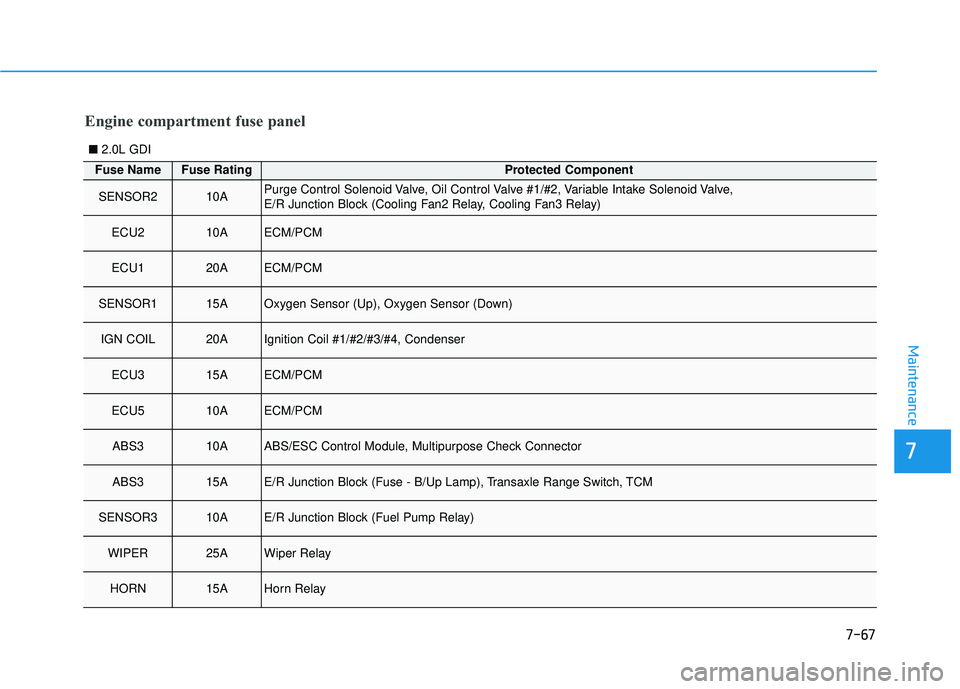
7-67
7
Maintenance
■2.0L GDI
Fuse NameFuse RatingProtected Component
SENSOR210APurge Control Solenoid Valve, Oil Control Valve #1/#2, Variable Intake Solenoid Valve,
E/R Junction Block (Cooling Fan2 Relay, Cooling Fan3 Relay)
ECU210AECM/PCM
ECU120AECM/PCM
SENSOR115AOxygen Sensor (Up), Oxygen Sensor (Down)
IGN COIL20AIgnition Coil #1/#2/#3/#4, Condenser
ECU315AECM/PCM
ECU510AECM/PCM
ABS310AABS/ESC Control Module, Multipurpose Check Connector
ABS315AE/R Junction Block (Fuse - B/Up Lamp), Transaxle Range Switch, TCM
SENSOR310AE/R Junction Block (Fuel Pump Relay)
WIPER25AWiper Relay
HORN15AHorn Relay
Engine compartment fuse panel
Page 442 of 495
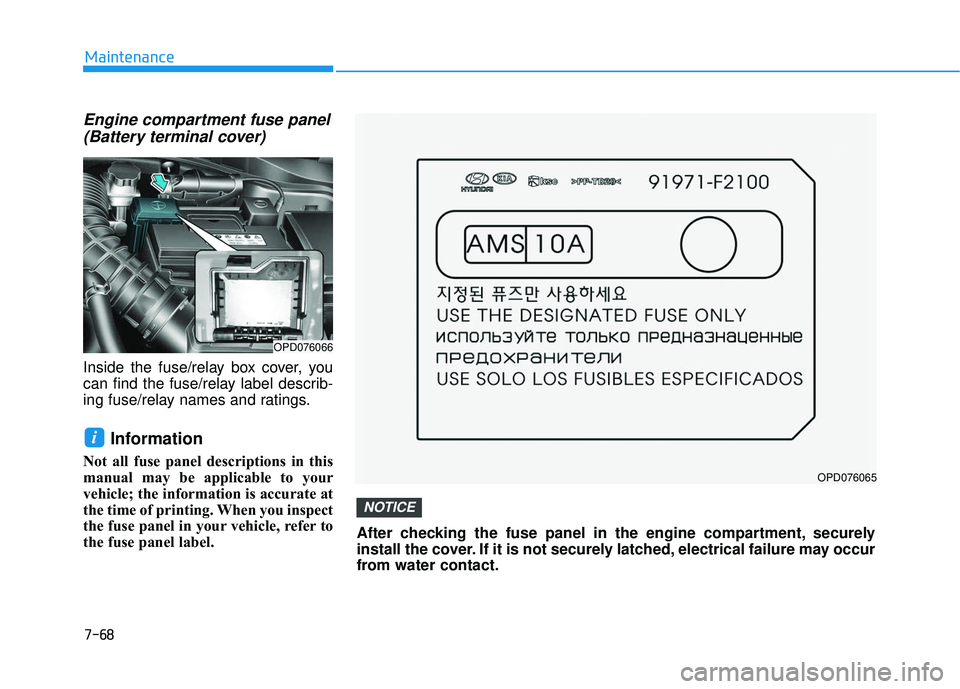
7-68
Maintenance
Engine compartment fuse panel(Battery terminal cover)
Inside the fuse/relay box cover, you
can find the fuse/relay label describ-
ing fuse/relay names and ratings.
Information
Not all fuse panel descriptions in this
manual may be applicable to your
vehicle; the information is accurate at
the time of printing. When you inspect
the fuse panel in your vehicle, refer to
the fuse panel label.
i
OPD076066
OPD076065
After checking the fuse panel in the engine compartment, securely
install the cover. If it is not securely latched, electrical failure may occur
from water contact.
NOTICE
Page 463 of 495
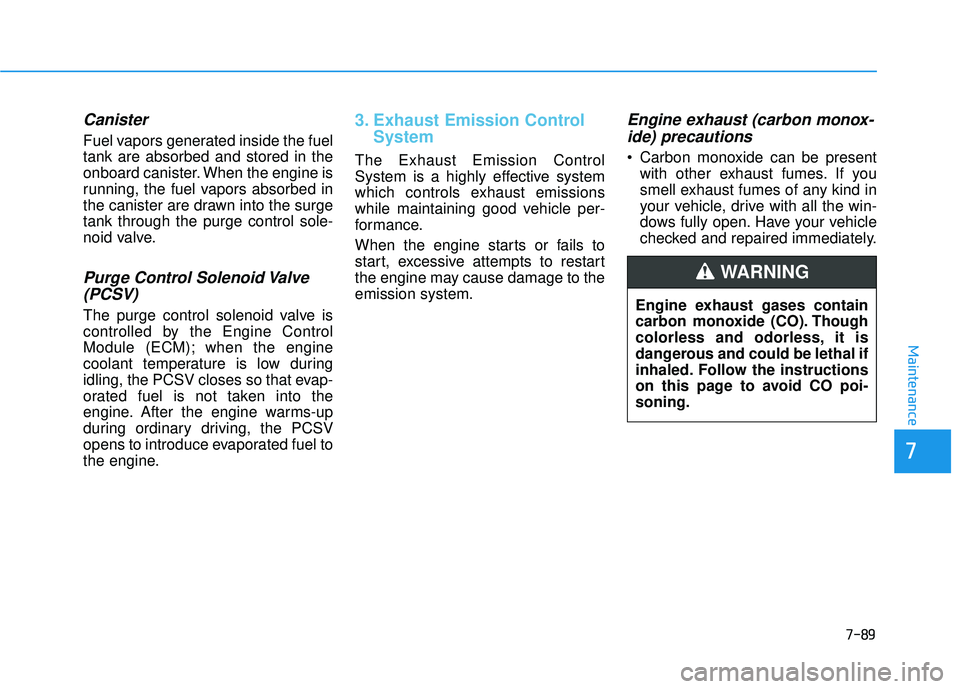
7-89
7
Maintenance
Canister
Fuel vapors generated inside the fuel
tank are absorbed and stored in the
onboard canister. When the engine is
running, the fuel vapors absorbed in
the canister are drawn into the surge
tank through the purge control sole-
noid valve.
Purge Control Solenoid Valve(PCSV)
The purge control solenoid valve is
controlled by the Engine Control
Module (ECM); when the engine
coolant temperature is low during
idling, the PCSV closes so that evap-
orated fuel is not taken into the
engine. After the engine warms-up
during ordinary driving, the PCSV
opens to introduce evaporated fuel to
the engine.
3. Exhaust Emission Control System
The Exhaust Emission Control
System is a highly effective system
which controls exhaust emissions
while maintaining good vehicle per-
formance.
When the engine starts or fails to
start, excessive attempts to restart
the engine may cause damage to the
emission system.
Engine exhaust (carbon monox-
ide) precautions
Carbon monoxide can be present
with other exhaust fumes. If you
smell exhaust fumes of any kind in
your vehicle, drive with all the win-
dows fully open. Have your vehicle
checked and repaired immediately.
Engine exhaust gases contain
carbon monoxide (CO). Though
colorless and odorless, it is
dangerous and could be lethal if
inhaled. Follow the instructions
on this page to avoid CO poi-
soning.
WARNING
Page 476 of 495
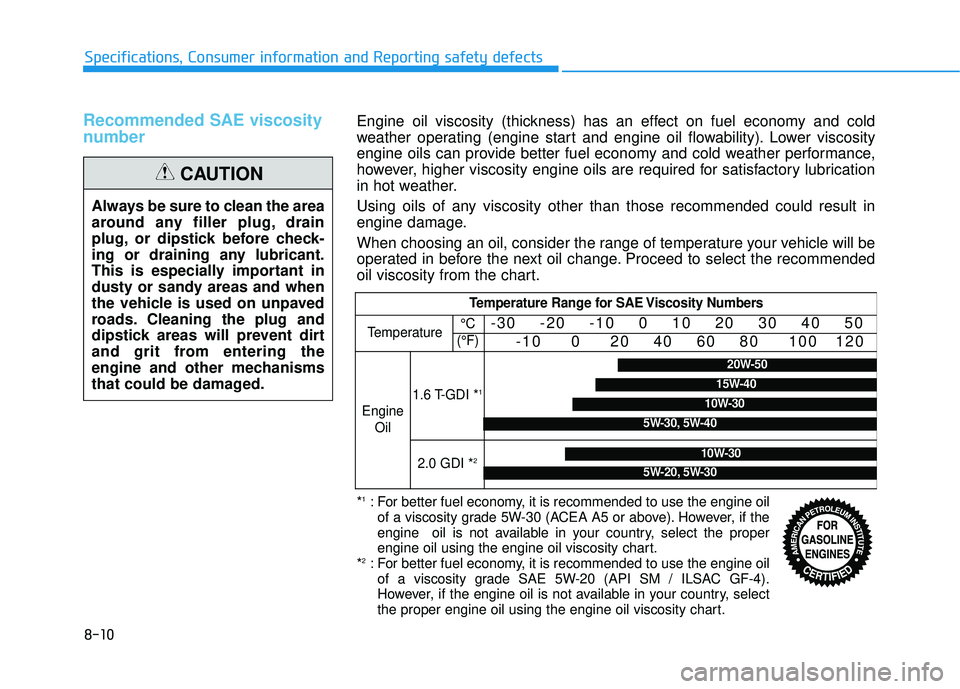
8-10
Specifications, Consumer information and Reporting safety defects
Recommended SAE viscosity
number
Always be sure to clean the area
around any filler plug, drain
plug, or dipstick before check-
ing or draining any lubricant.
This is especially important in
dusty or sandy areas and when
the vehicle is used on unpaved
roads. Cleaning the plug and
dipstick areas will prevent dirt
and grit from entering the
engine and other mechanisms
that could be damaged.
CAUTION
Temperature Range for SAE Viscosity Numbers
Temperature -30 -20 -10 0 10 20 30 40 50
-10 0 20 40 60 80 100 120
Engine Oil
1.6 T-GDI *1
2.0 GDI *2
°C
(°F)
*1: For better fuel economy, it is recommended to use the engine oil of a viscosity grade 5W-30 (ACEA A5 or above). However, if the
engine oil is not available in your country, select the proper
engine oil using the engine oil viscosity chart.
*
2: For better fuel economy, it is recommended to use the engine oil of a viscosity grade SAE 5W-20 (API SM / ILSAC GF-4).
However, if the engine oil is not available in your country, select
the proper engine oil using the engine oil viscosity chart.
5W-30, 5W-40
10W-30
15W-40
20W-50
10W-30
5W-20, 5W-30
Engine oil viscosity (thickness) has an effect on fuel economy and cold
weather operating (engine start and engine oil flowability). Lower viscosity
engine oils can provide better fuel economy and cold weather performance,
however, higher viscosity engine oils are required for satisfactory lubrication
in hot weather.
Using oils of any viscosity other than those recommended could result in
engine damage.
When choosing an oil, consider the range of temperature your vehicle will be
operated in before the next oil change. Proceed to select the recommended
oil viscosity from the chart.
Page 484 of 495
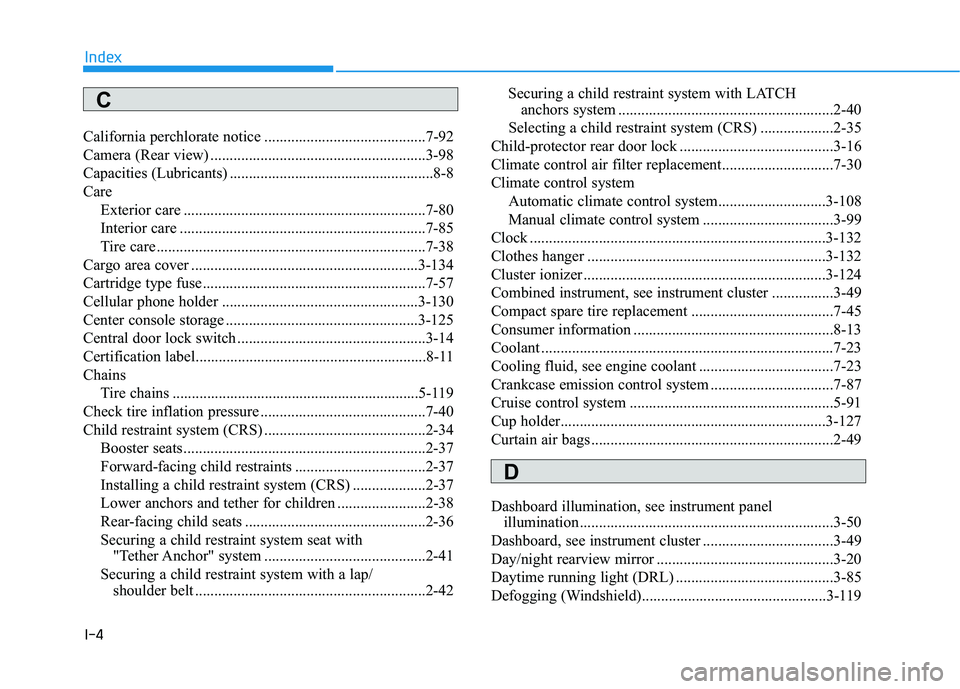
I-4
California perchlorate notice ..........................................7-92
Camera (Rear view) ........................................................3-98
Capacities (Lubricants) .....................................................8-8
CareExterior care ...............................................................7-80
Interior care ................................................................7-85
Tire care ......................................................................7-\
38
Cargo area cover ...........................................................3-134
Cartridge type fuse..........................................................7-57
Cellular phone holder ...................................................3-130
Center console storage ..................................................3-125
Central door lock switch .................................................3-14
Certification label............................................................8-11
Chains Tire chains ................................................................5-119
Check tire inflation pressure ...........................................7-40
Child restraint system (CRS) ..........................................2-34 Booster seats...............................................................2-37
Forward-facing child restraints ..................................2-37
Installing a child restraint system (CRS) ...................2-37
Lower anchors and tether for children .......................2-38
Rear-facing child seats ...............................................2-36
Securing a child restraint system seat with "Tether Anchor" system ..........................................2-41
Securing a child restraint system with a lap/ shoulder belt ............................................................2-42 Securing a child restraint system with LATCH
anchors system ........................................................2-40
Selecting a child restraint system (CRS) ...................2-35
Child-protector rear door lock ........................................3-16
Climate control air filter replacement.............................7-30
Climate control system Automatic climate control system............................3-108
Manual climate control system ..................................3-99
Clock ........................................................................\
.....3-132
Clothes hanger ..............................................................3-132
Cluster ionizer ...............................................................3-124
Combined instrument, see instrument cluster ................3-49
Compact spare tire replacement .....................................7-45
Consumer information ....................................................8-13
Coolant ........................................................................\
....7-23
Cooling fluid, see engine coolant ...................................7-23
Crankcase emission control system ................................7-87
Cruise control system .....................................................5-91
Cup holder.....................................................................3-1\
27
Curtain air bags ...............................................................2-49
Dashboard illumination, see instrument panel illumination..................................................................3-50
Dashboard, see instrument cluster ..................................3-49
Day/night rearview mirror ..............................................3-20
Daytime running light (DRL) .........................................3-85
Defogging (Windshield)................................................3-119
Index
D
C
Page 488 of 495
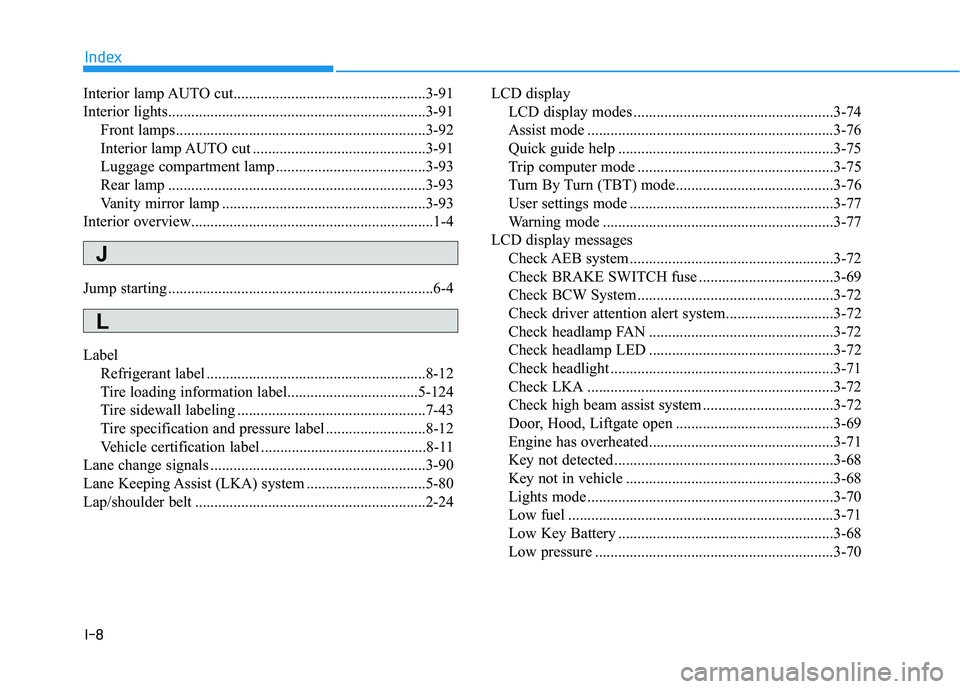
I-8
Interior lamp AUTO cut..................................................3-91
Interior lights...................................................................3-91Front lamps.................................................................3-92
Interior lamp AUTO cut .............................................3-91
Luggage compartment lamp .......................................3-93
Rear lamp ...................................................................3-93
Vanity mirror lamp .....................................................3-93
Interior overview...............................................................1-4
Jump starting .....................................................................6-4\
Label Refrigerant label .........................................................8-12
Tire loading information label..................................5-124
Tire sidewall labeling .................................................7-43
Tire specification and pressure label ..........................8-12
Vehicle certification label ...........................................8-11
Lane change signals ........................................................3-90
Lane Keeping Assist (LKA) system ...............................5-80
Lap/shoulder belt ............................................................2-24 LCD display
LCD display modes ....................................................3-74
Assist mode ................................................................3-76
Quick guide help ........................................................3-75
Trip computer mode ...................................................3-75
Turn By Turn (TBT) mode.........................................3-76
User settings mode .....................................................3-77
Warning mode ............................................................3-77
LCD display messages Check AEB system .....................................................3-72
Check BRAKE SWITCH fuse ...................................3-69
Check BCW System ...................................................3-72
Check driver attention alert system............................3-72
Check headlamp FAN ................................................3-72
Check headlamp LED ................................................3-72
Check headlight ..........................................................3-71
Check LKA ................................................................3-72
Check high beam assist system ..................................3-72
Door, Hood, Liftgate open .........................................3-69
Engine has overheated................................................3-71
Key not detected .........................................................3-68
Key not in vehicle ......................................................3-68
Lights mode ................................................................3-70
Low fuel .....................................................................3-7\
1
Low Key Battery ........................................................3-68
Low pressure ..............................................................3-70
Index
J
L